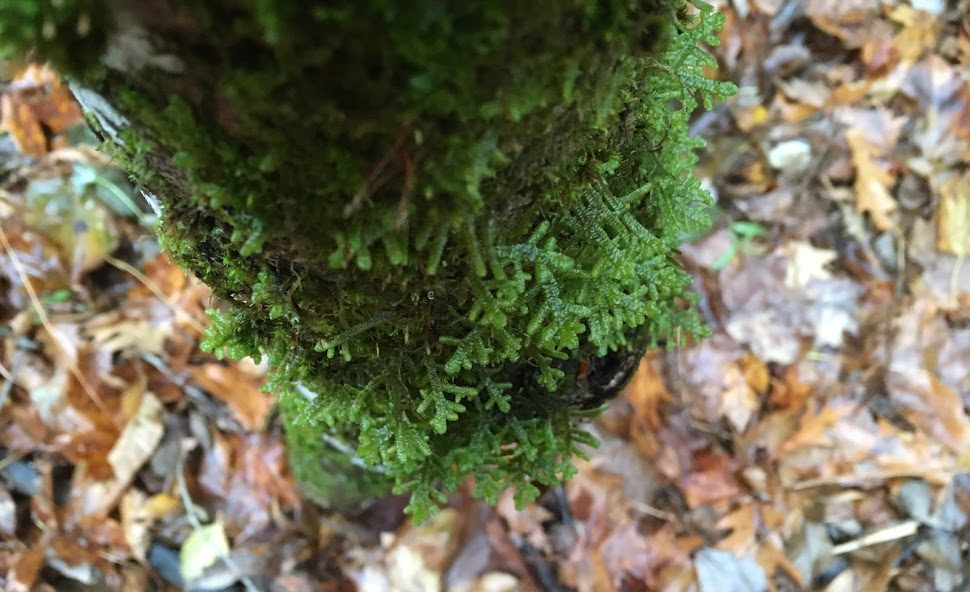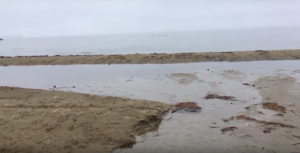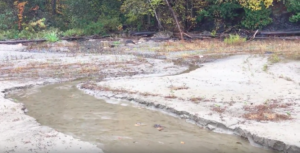Rain Event Gallery
Where does the rain go,
When it hits the leaf of the tree
And runs down to the ground?
Does it stop and join others,
Or go on alone,
Down to the ground.
Will it drip and fall the long way,
Or find its way down the trunk,
Down to the ground.
Forever traveling,
Never resting,
The rain goes back to the sky.
Many forces dictate how rain behaves – from chemical to physical. Water tension, slope, texture, and temperature all play a role in the journey of a single drop of rain. One drop almost never has enough velocity to make it to the ground on its own if it hits something before the ground. Even if it does manage to avoid landing on a leaf or a branch, it will have to work its way through the organic matter to find more water. Or it may pool on a leaf, or land in a stream or pond.
A collection of droplets can form a puddle if it still cannot find its way to the soil or a stream. A trickle may form and the rainwater may flow out of the forest and into a moving body of water that carries it far from where it started. Rain can be powerful when many drops come together. It can wash away soil and uproot trees and move boulders. Some rain is lost to the air as it evaporates when the sun returns.
There are signs left behind that it rained. Recent erosion and fresh but empty stream beds are an indication that it rained recently. Bare roots at the base of trees are another indicator that a place is often wet. Chemical reactions in the soil take place only when water is available regularly and signs are evident in soil coloration and texture. Other effects of rainfall can be observed for years after the rain fell. Landslides and terraced slopes are evidence that the ground became unstable, and a very likely cause would be that the soil became too moist from rain and the angle of repose changed.
Behavior of Rain
A droplet hit something – a leaf, a branch, a stone, a wall – and will either move down or stay still depending on the slope and the texture of the surface. A raindrop falling on a Maple leaf will behave differently than if it landed on a Hemlock needle or even a Pine needle. Water takes the path of least resistance even on the smallest scale.
One drop can become many and many can do more than just one. However, they still do the same things – run downhill, pick up debris, move particles, etc. The individual drops have a tendency to move toward each other, collect, pool, and then run downslope toward the ground.
Where droplets land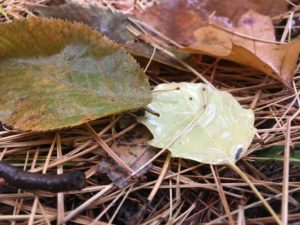
In a forested landscape, a drop of rain can have a hard time reaching the forest floor. It can land on many things before seeping into the soil. It may never reach the soil if there are enough droplets. Falling on the right leaf could send a little drop straight to the ground if it doesn’t land on another leaf below, or it could land on a Hemlock needle and be caught in a little cage of towering needles. Of course, once enough are caught in the same place they can rush through the bars of their cage and drip. Drip down to the next obstacle. A droplet could fall on a branch and, if the bark is smooth, maybe run down the branch to the trunk and down the trunk to the base of the tree and the awaiting soil. However, this would only happen if the branch or twig is at a steep incline, otherwise, the drops would accumulate and wait. They would wait until enough have collected in that specific place to fall. It is unlikely that one drop will get to the soil without making another stop or two. Most trees in New England have rough bark and will catch a single raindrop. The journey down the trunk of the tree will involve a lot of waiting for others to catch up enough so that they have enough momentum to break free of the water tension and attractiveness of the bark.
What gets wet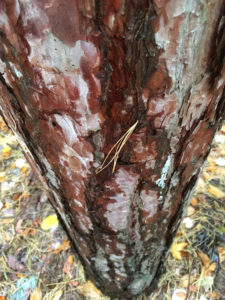
Rain begins and if you are standing in a forest you may not know immediately. It may sound like wind in the canopy. Once a drop hits your curious upturned face though, you will know. Not everything gets wet. Most of the water is caught by the leaves and branches, which get coated with water that stays and waits for more. It waits until there is enough to be pulled by gravity down the side of the tree. However, only one side of a trunk may get wet – the side the rain runs down or a side that is exposed to a canopy gap or the edge of the forest. The forest floor only gets wet in certain places; the majority of the rain only gets a few drops when the canopy is full and healthy and the rain is not too heavy.
Rain runs down one side of the trunk of the tree and that side of the base gets wet. A clearing allows drops to hit the herbaceous plants that are growing there and they are easily coated with water splashing off their neighbors. Small pools may form on the ground in the clearing. Back under the cover of the canopy, fallen leaves glistens where the canopy is thin and at the place where the branches of one tree meet the branches of another. There are wet and dry patches of the forest floor and some are just damp.
What it carries
A single drop of rain can collect and transport many particles. It can carry plant and fungi spores as well as a range of abiotic particles. The more drops the more power there is to move large particles and objects. A river, raging with snowmelt, can move immense boulders and tear downstream banks or trees that are just a little too close. A flood from heavy rains could topple trees and houses alike. The rain I saw carried sands and other small sediments from the forest to a runoff delta on a beach. The small stones were the first to drop out and then sands were strewn in trumpet-like feature from the mouth of the delta.
Water is a vital transport system in the reproductive cycle of many plants. While pollen and spores were not transported in the rain that I saw, come spring time it will be full of little spores and pollen particles being transported to new places. Many mosses and fungi can only reproduce in the presence of water, but not too much. Sperm cells must travel in water to the egg in order to fertilize it. The dispersal of spores is also heavily reliant on water for movement in order to colonize new patches.
What it erodes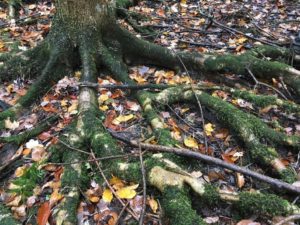
A single drop or a raging river or a flood erodes the surface with which it interacts. Water can be incredibly abrasive. The sand and other particles it carries scratch hard surfaces. The chemical composition of water eat away and dissolves some types of rocks. The very presence of water in soils on a steep bank can be enough to change the angle of repose and that land may slide down. One drop of rain that falls on a steep exposed slope is enough to remove particles of soil. Many drops doing this increases the rate of erosion and the chance that the whole thing will collapse. The brute force of water can be enough to wash away banks and large rocks.
Where it disappears
The “goal” of all water is to follow the path of least resistance to the lowest point it can get to. In the forest, the water that reaches the ground seeps between the leaves and soaks into the soil. Or it is carried out of the forest by a stream. At the forest’s edge and beyond, everything gets wet and the water makes little streams and pools where it cannot sink into the ground fast enough. On the beach, it makes a small delta that empties runoff into the lake where you cannot differentiate between rain and lake. Some rain disappears into the air. When the sun returns and the rain cloud recedes, the warmth of the sun’s rays evaporates some water from puddles and leaves and the surfaces or trunks and rocks. The rain never stays.
What this rain is doing
What it effects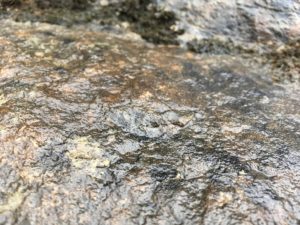
The rain that I observed was light and steady. I was in the Arms forest in Burlington, VT for a majority of the time and then at one end of Leddy Park. On the edge of the beach nearest the bike path, there was an escarpment. The bar soil was light colored and relatively sandy. A narrow path ran around side it and up into the forest between the beach and the bike path. A slump was at the base of the scarp. Too much moisture in the sandy soil caused half of the small hill to slide. Birches on one side are angled toward the scarp indicating that the land they are growing from was once horizontal and not slanted. This feature was formed during hurricane Irene in 2011.
However, rain does more than just destroy. It changes how things look and feel. It made a rocky outcropping slippery to touch and dangerous to climb. It pooled in the groves and crevices to make the rock shiny and bright. The moss that grew on it was full of water like a sponge. Excess water streamed out from one place and down the side of the rock. Even a little water was enough to give a rough rock a whole new look.
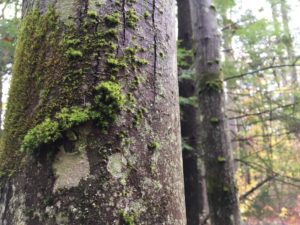 Everything is more alive in the rain. Colors are brighter and the plants are happy. Animals may bask in the sun, but plants bask in the rain. A heavy rain may cause plants to be battered and could even cause damage, but the extra water helps them to repair the damage more quickly. Moss, lichens, and fungi show perhaps the most change. Lichen and moss that appeared dry and dead the day before are now bright and green. It puffs out from the trunks of trees and is more vibrant than you could have imagined. Stiff lichens become supple and mushrooms poke their heads out from between the leaves and shelf fungi emerge. Molds grow quickly and reproduce while water is available. Rain means reproduction for these water reliant organisms.
Everything is more alive in the rain. Colors are brighter and the plants are happy. Animals may bask in the sun, but plants bask in the rain. A heavy rain may cause plants to be battered and could even cause damage, but the extra water helps them to repair the damage more quickly. Moss, lichens, and fungi show perhaps the most change. Lichen and moss that appeared dry and dead the day before are now bright and green. It puffs out from the trunks of trees and is more vibrant than you could have imagined. Stiff lichens become supple and mushrooms poke their heads out from between the leaves and shelf fungi emerge. Molds grow quickly and reproduce while water is available. Rain means reproduction for these water reliant organisms.
How it travels
I observed the rain in the forest as it fell and found its way downhill to a small valley with a stream. From the trees, the rain dripped down the trunks it ran into small pools that had formed beside the stream and were slowly emptying into it. The valley guided the water to a culvert under the bike path and then to the beach where it created its own path through the sand to the lake. A delta was formed and emptied into a pool that was stuck behind a buffer made by the waves. There was a way around this long mound of sand at either end that the water was slowly making its way through. Pools to stream to another pool and yet a larger pool was the path some of the rain took today. Another was through the soil and into the air.
In the lake, the rainwater will cycle and merge with the lake water. The nutrients and sediment it carried will disperse and settle to the lake bottom or stay in the delta or even be consumed by organisms. Water from the lake evaporates to make more rain. However, some of it flows north and eventually into the St. Lawrence River, which will eventually empty into the Atlantic. This rain is destined for a long journey. The water that stays in the lake is used by the people who live near it as recreation and a source of drinking water.
I am not sure where the rain I saw that day will end up or if it will even travel very far, but I know it is part of a global system that is cycling endlessly. This water has been on the planet for millennia and hopefully will remain here in a liquid state so that life can flourish for centuries to come.
Observations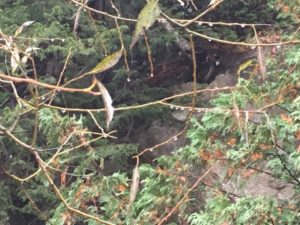
- The side of tree trunks gets wet but not the whole thing
- Not always the same side of the tree in a forest
- Depends on position
- Not always the same side of the tree in a forest
- Little deltas in the sand beach created by runoff from the upland forest
- Small drops make a splash, while large drops drip
- Rain collects and then runs down a twig or branch
- Like it is sticky
- Hydrogen bonds & water tension
- Like it is sticky
- Soil is fairly dry below the organic matter (leaf litter)
- Water collects in pools
- Colors are brighter and pop more
- Everything comes to life
- Tree trunks are like vertical landscapes with valleys and ridges
- Water clings to different surfaces differently (including dry vs wet)
- Small round balls on the petals of a flower
- Slick and shiny on the thick leaves of a plant
- Things that are already wet do not get droplets on them – the new drops just meld with the rest on the surface
- Rain is never constant
- Almost comes in waves or sheets
Testable Hypothesis
All life depends on the presence of liquid water. There is nothing that can survive in the complete absence of it. It influences everything. The cycle of water on our planet is never-ending. Water takes so many shapes and goes through so many processes; rain, mist, snow, ice, liquid, etc. In the forest, rainwater takes time to reach the forest floor. The canopy kind of acts like a very holey umbrella with many layers. However, it is more complex than that because the leaves in the canopy are much smaller than an umbrella the size of the whole forest canopy. In the forests of New England, trees are blessed with an abundance of water. However, they have to combat snow and ice in winter and have adapted brilliantly to their environment in most cases.
I am interested in the rate at which water seeps into the ground and how much of the actual rain gets to the ground. How does the rate of percolation change with different substrates? How does this rate influence what grows there? There is plenty of research that has been done on this subject, but I have read none of it and am still curious. I would enjoy testing the rate of percolation of water through different substrates and different combinations of substrates. If I were to design an experiment to test this, I would use hollow cylinders of known volume and filter a certain amount of water through each and time how long it took for a majority of the water to exit the bottom. I can compare the holding capacity of the different substrates as well. 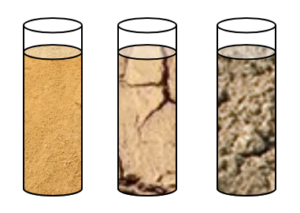
I would have several hollow cylinders with filters on the bottom to prevent soil from escaping. One cylinder would just contain a filter to determine how fast the water moved through it. All of the other cylinders would contain a different substrate. There are two methods that I would use to obtaining substrates. First, I could collect core samples from different forest types. Secondly, I could also use substrates of known proportions of sand, silt, and clay. This method would need an added component of organic matter as this is an important component in all forest soils. Many cylinders would need to be created to try different combinations.
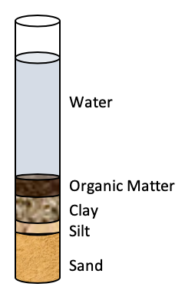 A few example cylinders: sand, loam, sand with 10%-50% organic matter, loam with 10%-50% organic matter, soil core from conifer dominant forest, soil core from hardwood dominant forest, and soil cores from different hydrologic zones. Any substrate that was not mixed in the lab with known parts would need to be tested for the composition. This could easily be done by letting a sample set in water after mixing it. The different particles will fall out of solution at different speeds. This will allow me to identify the percentages of humus, sand, silt, and clay in each sample.
A few example cylinders: sand, loam, sand with 10%-50% organic matter, loam with 10%-50% organic matter, soil core from conifer dominant forest, soil core from hardwood dominant forest, and soil cores from different hydrologic zones. Any substrate that was not mixed in the lab with known parts would need to be tested for the composition. This could easily be done by letting a sample set in water after mixing it. The different particles will fall out of solution at different speeds. This will allow me to identify the percentages of humus, sand, silt, and clay in each sample.
I would assume that the more organic matter a cylinder contains, the slower the water moves. The same would be true for substrates with smaller particles, clay, and silt, as the water would need to travel through smaller spaces between particles. Larger particles like sand would allow water to travel through very quickly as well as substrates with less organic matter. The number of different soils is infinite and I would never be able to test them all, but just a little knowledge goes a long way.
Images and graphics: Shelton, Sadie 2018

